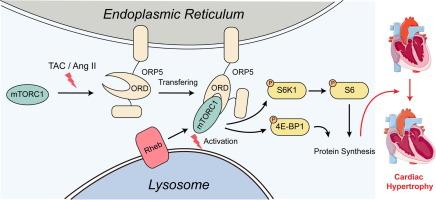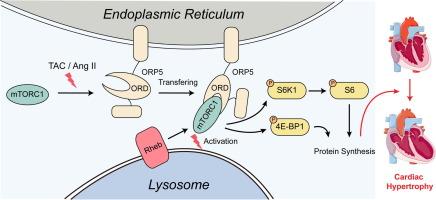ORP5 promotes cardiac hypertrophy by regulating the activation of mTORC1 on lysosome
IF 13
1区 综合性期刊
Q1 MULTIDISCIPLINARY SCIENCES
引用次数: 0
Abstract
Introduction
Oxysterol binding protein (OSBP)-related protein 5 (ORP5) mainly functions as a lipid transfer protein at membrane contact sites (MCS). ORP5 facilitates cell proliferation through the activation of mTORC1 signaling. While the pro-hypertrophic effects of mTORC1 are well-documented, the specific role of ORP5 in the context of pathological cardiac hypertrophy remains inadequately understood.
Methods
To investigate the role of ORP5 in pathological cardiac hypertrophy, AAV9-treated mice and neonatal rat ventricular myocytes (NRVMs) were utilized. Cardiac function, morphology, and mTORC1 signaling alterations induced by pro-hypertrophic stimuli were assessed in both myocardium and NRVMs. Additionally, a range of molecular techniques were employed to elucidate the regulatory mechanisms of ORP5 on mTORC1 in hypertrophied hearts.
Results
Increased expression of ORP5 was observed in the hearts of patients with hypertrophic cardiomyopathy (HCM), in mice subjected to transverse aortic constriction (TAC), and in NRVMs treated with angiotensin II (AngII). We found that ORP5 binds to mTOR in cardiomyocytes. Upon exposure to TAC surgery, ORP5-deficient hearts exhibited enhanced cardiac function, reduced cardiomyocyte hypertrophy, and diminished collagen deposition than wild type. Conversely, overexpression of ORP5 significantly aggravated hypertrophic responses in both hearts and NRVMs. Notably, the promotion of cardiac hypertrophy induced by ORP5 overexpression was reversed by rapamycin, an inhibitor of mTORC1. Mechanistically, our study elucidated that the ORD domain of ORP5 interacts with mTORC1, facilitating its translocation to the outer membrane of the lysosome for subsequent activation. This activation triggers the downstream signaling pathways involving S6K1 and 4E-BP1, which initiate protein synthesis, thereby promoting pathological cardiac hypertrophy.
Conclusions
Our findings provide the inaugural evidence that ORP5 facilitates pathological ventricular hypertrophy through the translocation of mTORC1 to the lysosome for subsequent activation. Consequently, ORP5 has the potential to serve as a diagnostic biomarker or therapeutic target for pathological cardiac hypertrophy in the future.


ORP5通过调节溶酶体上mTORC1的激活来促进心肌肥厚
氧甾醇结合蛋白(OSBP)相关蛋白5 (ORP5)主要作为膜接触位点(MCS)的脂质转移蛋白发挥作用。ORP5通过激活mTORC1信号通路促进细胞增殖。虽然mTORC1的促肥厚作用已被充分证明,但ORP5在病理性心脏肥厚中的具体作用仍未充分了解。方法采用aav9处理小鼠和新生大鼠心室肌细胞(nrvm),研究ORP5在病理性心肌肥厚中的作用。在心肌和nrvm中评估促肥厚刺激诱导的心功能、形态学和mTORC1信号的改变。此外,一系列分子技术被用于阐明ORP5在肥厚心脏中对mTORC1的调控机制。结果ORP5在肥厚性心肌病(HCM)患者、主动脉横缩(TAC)小鼠和血管紧张素II (AngII)治疗的nrvm心脏中表达升高。我们发现ORP5在心肌细胞中与mTOR结合。暴露于TAC手术后,orp5缺陷心脏表现出增强的心功能,心肌细胞肥大减少,胶原沉积减少。相反,ORP5的过表达显著加重了心脏和nrvm的肥厚反应。值得注意的是,ORP5过表达诱导的心肌肥厚被mTORC1抑制剂雷帕霉素逆转。在机制上,我们的研究阐明了ORP5的ORD结构域与mTORC1相互作用,促进其转运到溶酶体的外膜进行随后的激活。这种激活触发下游包括S6K1和4E-BP1的信号通路,启动蛋白质合成,从而促进病理性心肌肥大。结论我们的研究结果首次证明ORP5通过mTORC1易位到溶酶体并随后激活,从而促进病理性心室肥厚。因此,ORP5有可能在未来作为病理性心肌肥厚的诊断性生物标志物或治疗靶点。
本文章由计算机程序翻译,如有差异,请以英文原文为准。
求助全文
约1分钟内获得全文
求助全文
来源期刊

Journal of Advanced Research
Multidisciplinary-Multidisciplinary
CiteScore
21.60
自引率
0.90%
发文量
280
审稿时长
12 weeks
期刊介绍:
Journal of Advanced Research (J. Adv. Res.) is an applied/natural sciences, peer-reviewed journal that focuses on interdisciplinary research. The journal aims to contribute to applied research and knowledge worldwide through the publication of original and high-quality research articles in the fields of Medicine, Pharmaceutical Sciences, Dentistry, Physical Therapy, Veterinary Medicine, and Basic and Biological Sciences.
The following abstracting and indexing services cover the Journal of Advanced Research: PubMed/Medline, Essential Science Indicators, Web of Science, Scopus, PubMed Central, PubMed, Science Citation Index Expanded, Directory of Open Access Journals (DOAJ), and INSPEC.
 求助内容:
求助内容: 应助结果提醒方式:
应助结果提醒方式:


